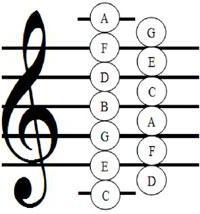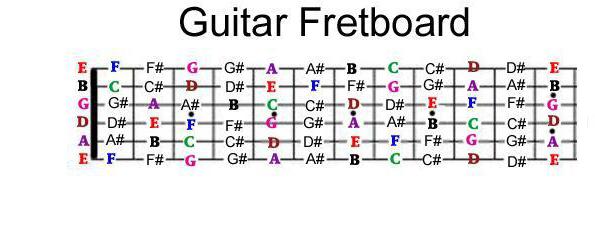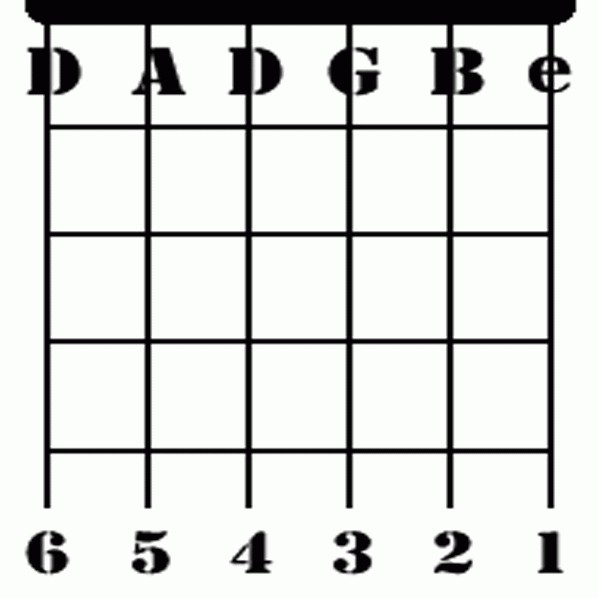Almost all novice guitarists are faced with the problem of understanding how the notes are arranged on the guitar. In fact, to understand this will not be difficult, even for those who do not perfectly know musical notation.
Sheet music for guitar
Knowing the location of the notes will help the novice musician quickly understand the principle of building chords and teach him to build any necessary harmonies. In this case, the guitarist no longer needs to memorize dozens or even hundreds of existing chords, which will undoubtedly significantly accelerate the learning process.
About notes and frets
Each guitar has about twenty frets. Their number varies depending on the type of guitar. For example, on a classical guitar - nineteen frets, on an electric guitar - twenty-two or more. The main thing is to remember that one fret equals one semitone. As for the notes themselves, it is important to know that between mi and fa, as well as between before and si, there is a semitone, that is, one fret. Between all other notes - a whole tone, that is, two frets. Remembering this principle, you can find all the notes on the neck of the guitar, knowing at least one. Every twelve frets, the notes are repeated, for example, on the fifteenth fret there will be the same note as on the third, only one octave higher. Octave - do, re, mi, fa, salt, la, si, that is, all the notes you know.
The
six-string guitar is characterized by the fact that each open string sounds the same as the previous one on the fifth fret. The exception is the second string, it has the same tone as the third string on the fourth fret. All this is necessary to know in order to be able to tune the guitar without the help of a tuner or various programs, as well as in order to bind strings to each other by notes.
Location
To begin, let's look at the location of the entire musical scale of the small octave. Note to (Latin designation C) you can find on the third fret of the fifth string or on the eighth fret of the sixth. Note re (or D) after two frets - on the fifth fret of the fifth string and the open fourth, because, as mentioned above, the open string is equal to the previous one on the fifth fret.

Mi (aka E) - second fret, fourth string. The Fa (or F, the easiest way to remember) will be on the third fret of the fourth string (remember, between mi and fa only a semitone or one fret). So, we go further, the note salt (its Latin designation G) will be in the fifth fret of the fourth, it is also the open third string. Try to find the note la (or A) yourself, and if you found it on the second fret of the third string, then you did everything right. Well, si (B) will be in the fourth fret of the third or open second string. The note until the next first octave is located on the first fret of the second string, since between s and c it is also only a semitone. Understanding this principle, you can easily find notes on the guitar, as well as half-tones of all other octaves. The Latin notation of the notes given in parentheses is also useful to know, because with their help chords are indicated. Say a chord in A minor is denoted as Am. The small letter m means a minor chord, but with major chords the letter is not written at all. For example, E major will be written as just E.
Halftone
If you are completely unaware of musical theory, then after reading the previous paragraph you may have a question: “So, in the third fret - before, in the fifth - re. And then what about in the fourth? ”And in the fourth fret there is the so-called C sharp (aka D flat). As mentioned above, between some (but not all) notes there are semitones, and each semitone has two names at once. Sharp (#) and flat (b) mean increase and decrease by one semitone, respectively. A semitone is called with respect to one of the notes between which it is located. Take for example the half-tone between la and si. It is higher than la, therefore it has the name la sharp. And he is below si, from here - sb flat. And of course, you must remember that between mi and fa, as well as between si and do, there are no midtones. Knowing this and making simple calculations, you can understand why an octave on one string is exactly twelve frets.
Recommendations
Beginners are advised to remember all the notes on the guitar with open strings, as well as on the fifth and tenth frets. Here all the notes are whole, without half-tones, knowing them, you can easily find the neighboring ones. Beginning guitarists are not recommended to memorize all notes and frets by heart, this is hard, useless work. It is enough just to understand the basic principles by which all notes on the guitar are located. The rest will come with game experience. Knowing notes, among other things, will help you in a process such as tuning a guitar. Sheet music will also help you write your own songs.
Frets
First of all, let's consider what notes on the guitar are located with open strings. Here, a special place is occupied by the notes mi. To tune the guitar, you must first find this particular note, since it is located immediately on two strings in the open position, namely on the first and sixth strings. On the first string, mi sounds in the first octave, on the sixth - in the big. Further from the bottom up: the fifth string is for the big octave, the fourth string is for the small octave, the third string is the salt of the small octave, the second string is the note of the B small octave.

Already knowing these notes, you can easily find all the rest and build various chords. We pass to the fifth fret. Here we have two la notes on the sixth and first string of the big and first octave, respectively. The fifth string is the D of the small octave. The fourth is the salt of the same octave. On the third string of the fifth fret, it is up to the next first octave. And the second string is mi of the same first octave. From all the above, the sequence is very easy to add. Well, let's move on to the tenth fret, here we have: the sixth string, like the first - re, but already small and second octaves. On the second string - small salt. The note until the first octave will be on the third string of the tenth fret. Further, on the fourth - the fa of the same first octave as la, which will be on the second string. And one more thing to keep in mind: notes for the guitar are usually written an octave higher, that is, a large octave will be equal to a small octave, a small octave will be equal to the first and so on.
Alternative systems
In addition to the standard guitar structure, which was laid out above, there are other alternative tunings in which there will already be different notes for the guitar. For beginners, it is enough to know at least the standard system, but you also need to remember the existence of others. For example, the so-called Drop D. Drop is translated from English as a drop. In all systems with such a prefix, the lower sixth string is lowered or “falls” by one tone relative to the others. That is, in order to put the guitar in Drop D, it is necessary to lower one sixth string to a tone, to re note, hence the name of the system.

Such a system is usually used on electric guitars, it, firstly, adds another tone to the available range, and secondly - it makes it easier to take fifths and the so-called “power chords”. Take Drop D, lower all the strings to tone and get Drop C - an even lower pitch. In such a system, various metal bands usually play heavy music, since the system makes the sound of the guitar quite low. In total, there are a large number of different alternative tunings, each musician chooses a system for himself, depending on the genre, vocal range of the singer and many other factors.
The most important thing
For someone who really wants to understand all the intricacies of the arrangement of notes, there is nothing complicated. The main thing is to have patience and not try to learn everything at once. All the necessary knowledge will come with experience, you only need to spend more time on the tool. In addition, knowledge of notes is not the most important thing in the learning process. Understanding the very process of playing the guitar and quickly searching for the right chords, harmonies and intervals are the things that bring you notes. A great many songs have been written for the guitar, but many authors did not even know musical notation. Take the most striking example - the group The Beatles. Not a single member of the group knew the notes, all the songs were written by ear. And this did not prevent the team from reaching the world level. So you need to prioritize yourself in your learning process, and most importantly - really want to learn how to play.